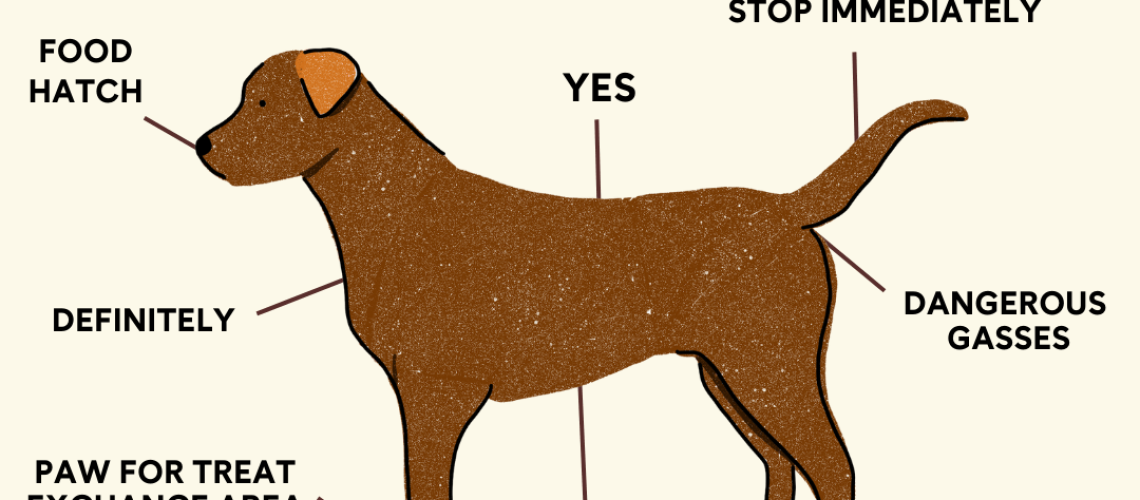Key Takeaways:
- Dogs have a natural instinct to seek physical affection and attention from their human companions.
- Petting releases endorphins in dogs, promoting feelings of relaxation and pleasure.
- Physical contact through petting helps strengthen the bond between dogs and their owners.
- Petting can provide dogs with a sense of security and reassurance, reducing anxiety and stress levels.
- The act of petting also serves as a form of social interaction for dogs, fulfilling their need for companionship and connection.
Introduction:
Have you ever wondered why dogs love being pet so much? It turns out there's more to it than just a simple scratch behind the ears. Understanding why dogs enjoy being pet can not only deepen our bond with our furry friends, but also improve their overall well-being. So, if you've ever wanted to know the secrets behind your dog's love for cuddles and belly rubs, keep reading! In this article, we'll explore the fascinating reasons why dogs go gaga for a little extra TLC. Get ready to discover the surprising benefits of petting your pup - it's time to unlock the code to their wagging tails and happy hearts.
Why do dogs love being petted?
The joy of petting for dogs
Have you ever noticed how happy and content dogs look when they are being petted? Dogs love being petted because it feels good to them! When you stroke a dog's fur, it can be very soothing and relaxing for them. It releases feel-good hormones in their brain, similar to how humans feel when they receive a massage.
In addition to the physical pleasure, petting also provides emotional comfort for dogs. Dogs are social animals, and they enjoy the attention and affection that comes with being petted. It makes them feel loved and cared for, which is essential for their overall well-being.
The benefits of petting for a dog's well-being
Petting not only brings joy to dogs but also has several benefits for their well-being. Regular petting can help reduce stress and anxiety in dogs. Just like humans, dogs can experience stress from various factors such as loud noises or changes in their environment. Petting helps them relax and calms their nervous system.
Petting also promotes better health in dogs. It can improve blood circulation and help maintain healthy skin and coat. Additionally, regular petting sessions can strengthen the bond between a dog and its owner, leading to a happier and more trusting relationship.
Do all dogs enjoy being petted?
While many dogs love being petted, it's important to remember that every dog is unique with its own preferences. Some dogs may not enjoy certain types of touch or may have specific areas on their bodies that they prefer not to be touched. It's crucial to pay attention to your dog's body language and respect their boundaries.
If a dog shows signs of discomfort or tries to move away when being petted, it's important to stop and give them space. Not all dogs enjoy physical contact, and that's okay. It's essential to find other ways to show your love and affection for your dog, such as playing together or offering treats.
The joy of petting for dogs
When you stroke a dog's fur, it can bring them immense joy and happiness. Dogs have sensitive skin and nerve endings that make petting a pleasurable experience for them. The gentle touch of your hand releases endorphins in their body, which are natural feel-good chemicals that can help reduce stress and anxiety. Petting also stimulates the release of oxytocin, often referred to as the "love hormone," in both humans and dogs. This hormone promotes feelings of trust, bonding, and overall well-being.
Petting is not only enjoyable for dogs but also serves as a form of communication between them and their human companions. It allows dogs to express their affection towards you and strengthens the emotional connection between you both. So next time you see a dog wagging its tail or leaning into your hand for more pets, remember that you're bringing them pure joy through the simple act of petting.
The Science Behind Petting
Research has shown that petting a dog can have numerous physiological benefits for both humans and dogs. When we stroke a dog's fur, it activates sensory receptors called Meissner's corpuscles located in their skin. These receptors send signals to the brain, triggering a cascade of positive responses.
Endorphins: The Feel-Good Chemicals
One of the key effects of petting is the release of endorphins in both humans and dogs. Endorphins are neurotransmitters that act as natural painkillers and mood enhancers. They create feelings of pleasure, reduce stress levels, and promote relaxation. So when you spend quality time petting your furry friend, you're not only making them happy but also boosting your own mood.
Oxytocin: The Love Hormone
Petting a dog also triggers the release of oxytocin, a hormone associated with social bonding and trust. Oxytocin is often referred to as the "love hormone" because it plays a crucial role in strengthening emotional connections between individuals. When you pet your dog, both you and your canine companion experience an increase in oxytocin levels, fostering a deeper bond and sense of attachment.
Do all dogs enjoy being petted?
Understanding a dog's preference for petting
Not all dogs enjoy being petted in the same way. Just like humans, dogs have their own preferences and boundaries when it comes to physical touch. Some dogs absolutely love being petted and will wag their tails with joy, while others may feel uncomfortable or even fearful. It is important to remember that each dog is an individual with unique needs and preferences.
Factors that influence a dog's enjoyment of petting
Several factors can influence whether a dog enjoys being petted or not. One factor is their breed or temperament. Some breeds are naturally more affectionate and crave physical contact, while others may be more independent and prefer less touching. Additionally, a dog's past experiences can shape their feelings towards petting. If a dog has had negative encounters with humans or has been mishandled in the past, they may become wary of physical touch.
Respecting a dog's boundaries
It is crucial to respect a dog's boundaries when it comes to petting. Pay attention to their body language and cues to determine if they are enjoying the interaction or not. Signs that a dog may not want to be petted include growling, showing teeth, trying to move away, or stiffening their body. If you encounter these signs, it is best to give the dog space and avoid further attempts at petting.
Remember, just because one dog enjoys being petted doesn't mean that all dogs will feel the same way. Each furry friend has their own preferences and comfort levels when it comes to physical touch.
The benefits of petting for a dog's well-being
Physical benefits of petting
Petting your furry companion can provide various physical benefits for them. When you stroke a dog's fur, it can help improve blood circulation and promote relaxation. Additionally, regular petting can help maintain a healthy coat by distributing natural oils and preventing matting or tangling.
Emotional benefits of petting
Petting is not only beneficial for a dog's physical well-being but also their emotional state. It releases endorphins, which are feel-good hormones that can reduce stress and anxiety in dogs. Regular petting sessions can create a sense of comfort and security for your furry friend, helping them feel loved and cared for.
The importance of gentle touch
When petting your dog, it is essential to use gentle and soothing strokes. Avoid applying too much pressure or pulling on their fur, as this may cause discomfort or even pain. Instead, opt for slow and rhythmic movements that your dog finds relaxing. Pay attention to their reactions to ensure they are enjoying the experience.
By understanding the physical and emotional benefits of petting, you can provide your canine companion with a positive and nurturing experience that contributes to their overall well-being.
How petting strengthens the bond between humans and dogs
The power of touch in building trust
Petting plays a significant role in strengthening the bond between humans and dogs. Touch is a powerful form of communication that helps build trust and deepen the connection between both parties. When you gently stroke your dog's fur, it signals affection and care, making them feel safe in your presence.
Petting as a form of social interaction
For dogs, being touched is an essential part of social interaction. Just like humans hug or shake hands to express friendship or love, dogs rely on physical contact to communicate their emotions. Regular petting sessions allow you to engage with your furry friend on an intimate level, fostering a sense of companionship and understanding.
Creating positive associations through petting
When you consistently provide your dog with gentle and enjoyable petting experiences, it creates positive associations in their mind. They associate your touch with feelings of comfort, happiness, and security. This positive reinforcement strengthens the bond between you and your furry companion, making them more receptive to training and responsive to your commands.
By recognizing the power of touch in building trust and establishing social connections, you can use petting as a tool to enhance the bond between you and your beloved canine friend.
Dogs' favorite spots to be petted
The top spot: Behind the ears
One of the most beloved spots for dogs to be petted is behind their ears. This area is highly sensitive, and gentle strokes or scratches can bring immense pleasure to your furry friend. Pay attention to their reaction – if they tilt their head or lean into your hand when you reach this spot, it's a clear sign that they enjoy it.
Chin and neck rubs
Another favorite spot for many dogs is their chin and neck area. Dogs often have loose skin in this region, making it easier for them to feel the sensation of being rubbed or scratched. Gently massaging this area can help relax your furry companion while also providing a delightful experience for them.
Belly rubs for ultimate bliss
Belly rubs are often considered the pinnacle of pleasure for dogs. Many dogs absolutely adore having their bellies rubbed, which can induce a state of pure bliss. However, not all dogs enjoy belly rubs immediately or from everyone. It is crucial to establish trust with your dog before attempting belly rubs as some may find it too vulnerable or invasive initially.
Remember that each dog may have unique preferences when it comes to favorite petting spots. Observe their reactions and body language to identify the areas they enjoy the most, and tailor your petting sessions accordingly.
Signs that a dog doesn't want to be petted
Body language cues
Dogs communicate their discomfort or disinterest in being petted through their body language. Look out for signs such as a stiff body, tense muscles, ears pinned back, or a closed mouth. These cues indicate that the dog may not be receptive to physical touch at that moment.
Avoiding eye contact
If a dog avoids making eye contact with you or turns their head away when you attempt to pet them, it is a clear indication that they do not want to be touched. Dogs use this avoidance behavior as a way of setting boundaries and signaling their preference for personal space.
Growling or snapping
In extreme cases, dogs may growl or snap when they do not want to be petted. This aggressive behavior is their way of expressing discomfort or fear. It is crucial to respect these warning signs and immediately stop attempting to pet the dog.
By understanding and respecting a dog's communication signals, you can ensure that your interactions with them are positive and enjoyable for both parties involved.
In conclusion, dogs enjoy being pet because it feels good and comforting to them. Petting helps strengthen the bond between dogs and their owners, making them happy and content.
Do dogs like the feeling of being pet?
What is the reason for dogs enjoying being petted? The straightforward answer is that it gives them pleasure and they can sense your positive energy towards them in that moment.
Why do dogs like human affection?
Snuggling: While certain dog breeds are known for their independence, even these breeds enjoy cuddling with their preferred individuals. Physical touch triggers the release of oxytocin, a hormone associated with love, in a dog's brain. Petting and cuddling help reinforce the bond between you and your canine companion.
Do dogs get tired of being petted?
While some dogs may tolerate having their face petted or head patted by familiar and trusted individuals, the majority of dogs do not actually enjoy this type of interaction. Even a beloved family dog may subtly lean away when someone tries to pet their face.
Why do dogs like a person so much?
Researchers analyzed the impact of oxytocin on the social behavior of dogs towards humans and other dogs. Their findings suggest that oxytocin increases a dog's desire to engage socially with both their canine companions (like in the movie "Lady and the Tramp") and their human companions.
Do dogs understand why we pet them?
Petting is a way that humans show affection to dogs and can have a positive impact on their mental well-being. Research indicates that when dogs are petted and given attention by humans, their brains release a hormone called Oxytocin, also known as the love hormone. This suggests that petting is not only enjoyable for dogs, but also helps to support their emotional health.
Do pet dogs think they are human?
On the other hand, dogs probably do not contemplate their categorization at all. Dogs live in the present moment, just being themselves in their lovable and charming way. They do not need to be aware of being dogs in order to be part of a group or enjoy cuddling on the couch, without having to think of themselves as humans.

















